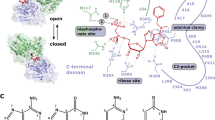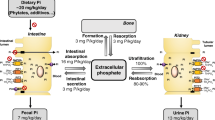Abstract
The enzyme adenosine kinase (AK) plays a central role in regulating the intracellular and interstitial concentration of the purine nucleoside adenosine (Ado). In view of the beneficial effects of Ado in protecting tissues from ischemia and other stresses, there is much interest in developing AK inhibitors, which can regulate Ado concentration in a site- and event-specific manner. The catalytic activity of AK from different sources is dependent upon the presence of activators such as phosphate (Pi). In this work we describe several new phosphorylated compounds which either activate or inhibit AK. The compounds acetyl phosphate, carbamoyl phosphate, dihydroxyacetone phosphate and imidodiphosphate were found to stimulate AK activity in a dose-dependent manner comparable to that seen with Pi. In contrast, a number of phosphonate and bisphosphonate derivatives, which included clodronate and etidronate, were found to inhibit the activity of purified AK in the presence of Pi. These AK inhibitors (viz. clodronate, etidronate, phosphonoacetic acid, 2-carboxyethylphosphonic acid, N-(phosphonomethyl)-glycine and N-(phosphonomethyl)iminodiacetic acid), at concentrations at which they inhibited AK, were also shown to inhibit the uptake of 3H-adenosine and its incorporation into macromolecules in cultured mammalian cells, indicating that they were also inhibiting AK in intact cells. The drug concentrations at which these effects were observed showed limited toxicity to the cultured cells, indicating that these effects are not caused by cellular toxicity. These results indicate that the enzyme AK provides an additional cellular target for the clinically widely used bisphosphonates and related compounds, which could possibly be exploited for a new therapeutic application. Our structure–activity studies on different AK activators and inhibitors also indicate that all of the AK activating compounds have a higher partial positive charge (δ+) on the central phosphorous atom in comparison to the inhibitors. This information should prove helpful in the design and synthesis of more potent inhibitors of AK.
Similar content being viewed by others
Abbreviations
- Ado:
-
adenosine
- AK:
-
adenosine kinase
- ADA:
-
adenosine deaminase
- EHNA:
-
erythro-9-(2-hydroxyl-3-nonyl) adenine
- AP:
-
acetyl phosphate
- CP:
-
carbamoyl phosphate
- DHAP:
-
dihydroxyacetone phosphate
- IDP:
-
imidodiphosphate
- MPA:
-
methylphosphonic acid
- DEPAA:
-
diethylphosphonoacetic acid
- PAA:
-
phosphonoacetic acid
- PFA:
-
phosphonoformic acid
- CEPA:
-
2-carboxyethylphosphonic acid
- PMG:
-
N-(phosphonomethyl)-glycine
- PMIA:
-
N-(phosphonomethyl)iminodiacetic acid
- AR:
-
adenosine receptor
- 5′NH2dAdo:
-
5′-amino, 5′-deoxyadenosine
- 5IT:
-
5-iodotubercidin
- 5′d-5IT:
-
5′-deoxy, 5-iodotubercidin
- MOPAC:
-
molecular orbital package
- MNDO:
-
modified neglect of diatomic overlap
References
Chang CH, Cha S, Brockman RW, Bennett LL, Jr.: Kinetic studies of adenosine kinase from L1210 cells: A model enzyme with a two-site ping-pong mechanism. Biochemistry 22: 600–611, 1983
Lindberg B, Klenow H, Hansen K: Some properties of partially purified mammalian adenosine kinase. J Biol Chem 242: 350–356, 1967
Palella TD, Andres CM, Fox IH: Human placental adenosine kinase. Kinetic mechanism and inhibition. J Biol Chem 255: 5264–5269, 1980
Miller RL, Adamczyk DL, Miller WH, Koszalka GW, Rideout JL, Beacham LM, III, Chao EY, Haggerty JJ, Krenitsky TA, Elion GB: Adenosine kinase from rabbit liver. II. Substrate and inhibitor specificity. J Biol Chem 254: 2346–2352, 1979
Mimouni M, Bontemps F, Van den BG: Kinetic studies of rat liver adenosine kinase. Explanation of exchange reaction between adenosine and AMP. J Biol Chem 269: 17820–17825, 1994
Newby AC: The role of adenosine kinase in regulating adenosine concentration. Biochem J 226: 343–344, 1985
de Fazio A, Kosic JD, Moir RD, Bagnara AS: Evidence against the compartmentation of adenosine kinase and adenosine deaminase activities in human erythrocytes. FEBS Lett 113: 215–217, 1980
Berne RM: The role of adenosine in the regulation of coronary blood flow. Circ Res 47: 807–813, 1980
Dawicki DD, Agarwal KC, Parks RE, Jr.: Role of adenosine uptake and metabolism by blood cells in the antiplatelet actions of dipyridamole, dilazep and nitrobenzylthioinosine. Biochem Pharmacol 34: 3965–3972, 1985
Grisham MB, Hernandez LA, Granger DN: Adenosine inhibits ischemia-reperfusion-induced leukocyte adherence and extravasation. Am J Physiol 257: H1334–H1339, 1989
Grover GJ, Sleph PG, Dzwonczyk S: Role of myocardial ATP-sensitive potassium channels in mediating preconditioning in the dog heart and their possible interaction with adenosine A1-receptors. Circulation 86: 1310–1316, 1992
Gunther GR, Herring MB: Inhibition of neutrophil superoxide production by adenosine released from vascular endothelial cells. Ann Vasc Surg 5: 325–330, 1991
Schrader J, Haddy FJ, Gerlach E: Release of adenosine, inosine and hypoxanthine from the isolated guinea pig heart during hypoxia, flow-autoregulation and reactive hyperemia. Pflugers Arch 369: 1–6, 1977
Daly JW: Adenosine receptors: Targets for future drugs. J Med Chem 25: 197–207, 1982
Ralevic V, Burnstock G: Receptors for purines and pyrimidines. Pharmacol Rev 50: 413–492, 1998
Bong GW, Rosengren S, Firestein GS: Spinal cord adenosine receptor stimulation in rats inhibits peripheral neutrophil accumulation. The role of N-methyl-D-aspartate receptors. J Clin Invest 98: 2779–2785, 1996
Firestein GS, Bullough DA, Erion MD, Jimenez R, Ramirez-Weinhouse M, Barankiewicz J, Smith CW, Gruber HE, Mullane KM: Inhibition of neutrophil adhesion by adenosine and an adenosine kinase inhibitor. The role of selectins. J Immunol 154: 326–334, 1995
Headrick JP, Gauthier NS, Morrison R, Matherne GP: Cardioprotection by K(ATP) channels in wild-type hearts and hearts overexpressing A(1)-adenosine receptors. Am J Physiol Heart Circ Physiol 279: H1690–H1697, 2000
Ramkumar V, Hallam DM, Nie Z: Adenosine, oxidative stress and cytoprotection. Jpn J Pharmacol 86: 265–274, 2001
Ahlijanian MK, Takemori AE: Effects of (−)-N6-(R-phenylisopropyl)-adenosine (PIA) and caffeine on nociception and morphine-induced analgesia, tolerance and dependence in mice. Eur J Pharmacol 112: 171–179, 1985
DeLander GE, Hopkins CJ: Involvement of A2 adenosine receptors in spinal mechanisms of antinociception. Eur J Pharmacol 139: 215–223, 1987
Holmgren M, Hednar T, Nordberg G, Mellstrand T: Antinociceptive effects in the rat of an adenosine analogue, N6-phenylisopropyladenosine. J Pharm Pharmacol 35: 679–680, 1983
Holmgren M, Hedner J, Mellstrand T, Nordberg G, Hedner T: Characterization of the antinociceptive effects of some adenosine analogues in the rat. Naunyn Schmiedebergs Arch Pharmacol 334: 290–293, 1986
Post C: Antinociceptive effects in mice after intrathecal injection of 5′-N-ethylcarboxamide adenosine. Neurosci Lett 51: 325–330, 1984
Dunwiddie TV, Worth T: Sedative and anticonvulsant effects of adenosine analogs in mouse and rat. J Pharmacol Exp Ther 220: 70–76, 1982
Malhotra J, Gupta YK: Effect of adenosine receptor modulation on pentylenetetrazole-induced seizures in rats. Br J Pharmacol 120: 282–288, 1997
Phillis JW, Wu PH: Roles of adenosine and adenine nucleotides in the central nervous system. In: JW Daly, JW Phillis, Y Kuroda, H Shimizu and M Ui (eds). Physiology and Pharmacology of Adenosine Derivatives, Raven Press, New York, 1983
Mullane K, Bullough D: Harnessing an endogenous cardioprotective mechanism: Cellular sources and sites of action of adenosine. J Mol Cell Cardiol 27: 1041–1054, 1995
Gupta RS: Adenosine-AMP exchange activity is an integral part of the mammalian adenosine kinase. Biochem Mol Biol Int 39: 493–502, 1996
Hao W, Gupta RS: Pentavalent ions dependency of mammalian adenosine kinase. Biochem Mol Biol Int 38: 889–899, 1996
Maj M, Singh B, Gupta RS: The influence of inorganic phosphate on the activity of adenosine kinase. Biochim Biophys Acta 1476: 33–42, 2000
Park J, Singh B, Maj MC, Gupta RS: Phosphorylated derivatives that activate or inhibit mammalian adenosine kinase provide insights into the role of pentavalent ions in AK catalysis. Protein J 23: 167–177, 2004
Rogers MJ, Gordon S, Benford HL, Coxon FP, Luckman SP, Monkkonen J, Frith JC: Cellular and molecular mechanisms of action of bisphosphonates. Cancer 88: 2961–2978, 2000
Santini D, Vespasiani GU, Vincenzi B, Picardi A, Vasaturo F, La Cesa A, Onori N, Scarpa S, Tonini G: The antineoplastic role of bisphosphonates: From basic research to clinical evidence. Ann Oncol 14: 1468–1476, 2003
Maj MC, Singh B, Gupta RS: Pentavalent ions dependency is a conserved property of adenosine kinase from diverse sources: identification of a novel motif implicated in phosphate and magnesium ion binding and substrate inhibition. Biochemistry 41: 4059–4069, 2002
Stewart JJP: Special issue-Mopac-A semiempirical molecular-orbital program. J Comput Aided Mol Des 4: 1–45, 1990
Dewar MJS, Thiel W: Ground-states of molecules. 38. Mndo method-Approximations and parameters. J Am Chem Soc 99: 4899–4907, 1977
Besler BH, Merz KM, Kollman PA: Atomic charges derived from semiempirical methods. J Comput Chem 11: 431–439, 1990
Luque FJ, Illas F, Orozco M: Comparative-study of the molecular electrostatic potential obtained from different wave-functions – Reliability of the semiempirical Mndo wave-function. J Comput Chem 11: 416–430, 1990
Jiang N, Kowaluk EA, Lee CH, Mazdiyasni H, Chopp M: Adenosine kinase inhibition protects brain against transient focal ischemia in rats. Eur J Pharmacol 320: 131–137, 1997
Kowaluk EA, Kohlhaas KL, Bannon A, Gunther K, Lynch JJ, III, Jarvis MF: Characterization of the effects of adenosine kinase inhibitors on acute thermal nociception in mice. Pharmacol Biochem Behav 63: 83–91, 1999
Miller LP, Jelovich LA, Yao L, DaRe J, Ugarkar B, Foster AC: Pre- and peristroke treatment with the adenosine kinase inhibitor, 5′-deoxyiodotubercidin, significantly reduces infarct volume after temporary occlusion of the middle cerebral artery in rats. Neurosci Lett 220: 73–76, 1996
Wiesner JB, Ugarkar BG, Castellino AJ, Barankiewicz J, Dumas DP, Gruber HE, Foster AC, Erion MD: Adenosine kinase inhibitors as a novel approach to anticonvulsant therapy. J Pharmacol Exp Ther 289: 1669–1677, 1999
Davies LP, Baird-Lambert J, Marwood JF: Studies on several pyrrolo[2,3-d]pyrimidine analogues of adenosine which lack significant agonist activity at A1 and A2 receptors but have potent pharmacological activity in vivo. Biochem Pharmacol 35: 3021–3029, 1986
Ugarkar BG, Castellino AJ, DaRe JM, Kopcho JJ, Wiesner JB, Schanzer JM, Erion MD: Adenosine kinase inhibitors. 2. Synthesis, enzyme inhibition, and antiseizure activity of diaryltubercidin analogues. J Med Chem 43: 2894–2905, 2000
Ugarkar BG, DaRe JM, Kopcho JJ, Browne CE, III, Schanzer JM, Wiesner JB, Erion MD: Adenosine kinase inhibitors. 1. Synthesis, enzyme inhibition, and antiseizure activity of 5-iodotubercidin analogues. J Med Chem 43: 2883–2893, 2000
Russell RG, Rogers MJ: Bisphosphonates: From the laboratory to the clinic and back again. Bone 25: 97–106, 1999
Schenk R, Merz WA, Muhlbauer R, Russell RG, Fleisch H: Effect of ethane-1-hydroxy-1,1-diphosphonate (EHDP) and dichloromethylene diphosphonate (Cl 2 MDP) on the calcification and resorption of cartilage and bone in the tibial epiphysis and metaphysis of rats. Calcif Tissue Res 11: 196–214, 1973
Chaudhary K, Darling JA, Fohl LM, Sullivan WJ, Jr., Donald RG, Pfefferkorn ER, Ullman B, Roos DS: Purine salvage pathways in the apicomplexan parasite Toxoplasma gondii. J Biol Chem 279: 31221–31227, 2004
Datta R, Das I, Sen B, Chakraborty A, Adak S, Mandal C, Datta AK: Mutational analysis of the active site residues crucial for catalytic activity of adenosine kinase from Leishmania donovani. Biochem J 2004
Mathews II, Erion MD, Ealick SE: Structure of human adenosine kinase at 1.5 Å resolution. Biochemistry 37: 15607–15620, 1998
Schumacher MA, Scott DM, Mathews II, Ealick SE, Roos DS, Ullman B, Brennan RG: Crystal structures of Toxoplasma gondii adenosine kinase reveal a novel catalytic mechanism and prodrug binding. J Mol Biol 298: 875–893, 2000
Sigrell JA, Cameron AD, Jones TA, Mowbray SL: Structure of Escherichia coli ribokinase in complex with ribose and dinucleotide determined to 1.8 Å resolution: insights into a new family of kinase structures. Structure 6: 183–193, 1998
Author information
Authors and Affiliations
Corresponding author
Rights and permissions
About this article
Cite this article
Park, J., Singh, B. & Gupta, R.S. Inhibition of adenosine kinase by phosphonate and bisphosphonate derivatives. Mol Cell Biochem 283, 11–21 (2006). https://doi.org/10.1007/s11010-006-2216-7
Received:
Accepted:
Issue Date:
DOI: https://doi.org/10.1007/s11010-006-2216-7




